Impress your clients with modern, stunning, fully customizable website templates • Ad
I’ve been accepting guest posts on my WordPress blog (has been sold) for some time now, and I’m getting pretty good at detecting spun articles, even though it’s quite a hard thing to do.
Today, I reviewed another guest post which I found out to be spun, so I decided to share with you some methods that I use, along with examples.
So, let’s get to it!
1. Use a Tool to Detect Poorly Spun Articles
Even though spun checking tools are not reliable, some authors do a very poor job at spinning articles.
Sometimes, they don’t modify a whole phrase, so it gets detected by plagiarism tools.
If that’s the case, I finish my detective job in a few minutes.
Therefore, the first thing I do is to use a plagiarism tool called Quetext.
After checking several other tools, this is the one I currently trust and like the most. Quetext is easy to use and has been accurate so far.
For demonstration purposes, I checked a phrase from one of my WordPress posts to show you how it looks like.

If this doesn’t spot anything, which will happen in most cases, try the other methods.
2. Checking Articles with the Same Topic
This is the most efficient method so far!
This is how I detect most of the spun articles that I receive, including the last one, today.
Basically, what you need to do is to use the post’s title or topic and perform a search using a search engine.
I recommend Google, Bing or DuckDuckGo for better, accurate results.
2. 1. Searching for articles with the same topic
Let’s take the guest post I reviewed today as an example.
The title was: “Best Proofreading Tips for WordPress Bloggers”.
I started by making a search using “proofreading tips for WordPress bloggers”.

I didn’t include “best” because I’m interested in all posts about “proofreading tips for WordPress bloggers”.
I could have removed “WordPress” as well from the search query, which would have been my second step, but I didn’t have to since I found what I was looking for.
My point is: Perform different searches using different queries related to the topic to find more possible spun sources.
2. 2. Going through the articles
You don’t need to read all the articles with the utmost attention because it will take a lot of time and drive you nuts.
Step 1
The first thing you should do is to scroll through the article and look at its sections to see if you find something similar to what’s in your post, such as images, links, subheadings, etc. Things that can be noticed quickly.
For example, when I detected the spun content today, I was scrolling through an article, and a link to a tool, along with an image, draw my attention because they were mentioned in the guest post as well.
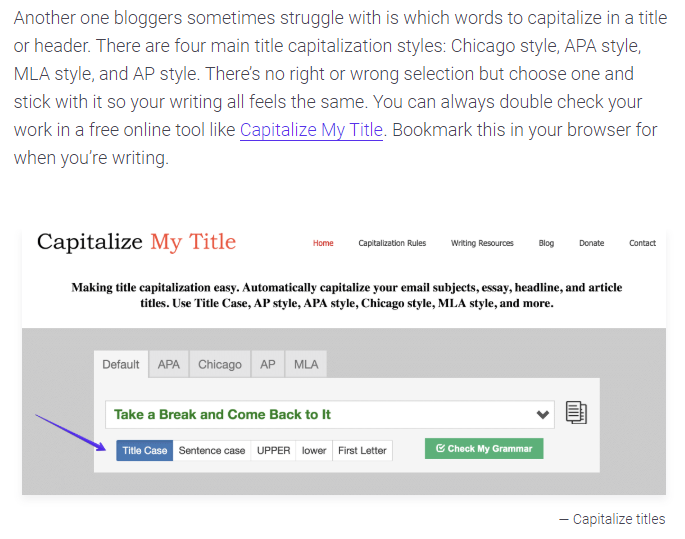
Screenshot from the original article
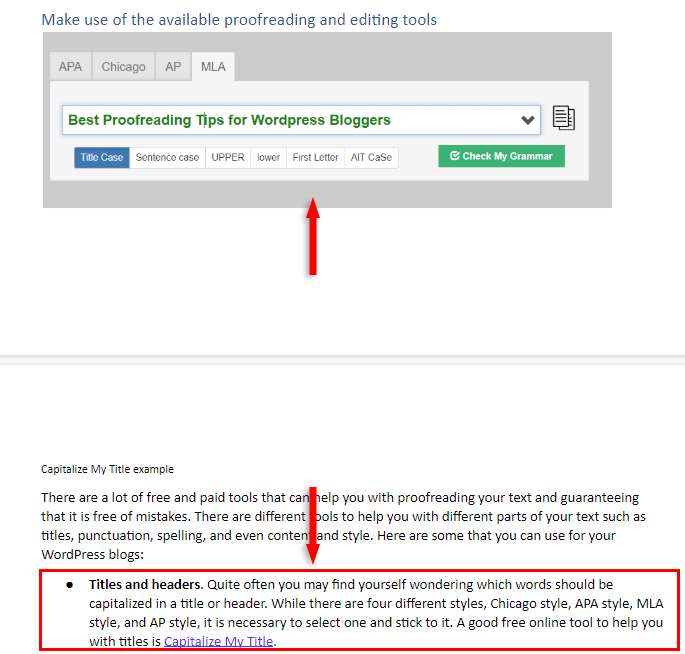
Screenshot from the guest post
So, I read the text around them and guess what? The paragraph from the guest post was copied from there and only slightly modified.
Here’s the paragraph from the guest post that I received:

Here’s the original paragraph used from Kinsta’s post:

I highlighted the parts that are obviously copied and slightly modified.
So, just by spotting a similar image and tool raised a red flag that helped me to detect the spun content.
And that’s all the proof I need!
One spun paragraph is enough for me to believe that there could be more, or even that the whole article is spun.
Step 2
You could also search for certain keywords from your possibly spun content in the articles that you find.
For example, if I wanted to search for the Capitalize My Title tool in other articles, so I can check the text around it for similarities, I’d press Ctrl+F on my keyboard (Cmd+F on macOS) and type in “Capitalize My Title”.
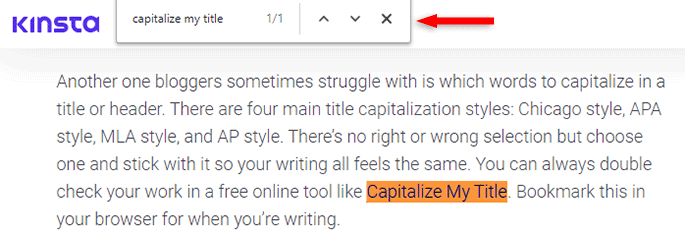
You can do this with several keywords to quickly see if the articles you check have tools or other things that are also mentioned in your post.
Then, check the text around them and see if it has been copied and modified.
2. 3. But how can I check so many articles?
In almost all cases, you won’t have to search through many articles.
They normally spun content from top articles found on Google.
If they don’t bother reading your requirements, proofread their article before sending it, and so on, they won’t bother searching to spin articles that are not under your nose. 😃
How many articles did you think I checked before detecting the spun content today?
One! Yep, the first search result was the winner.
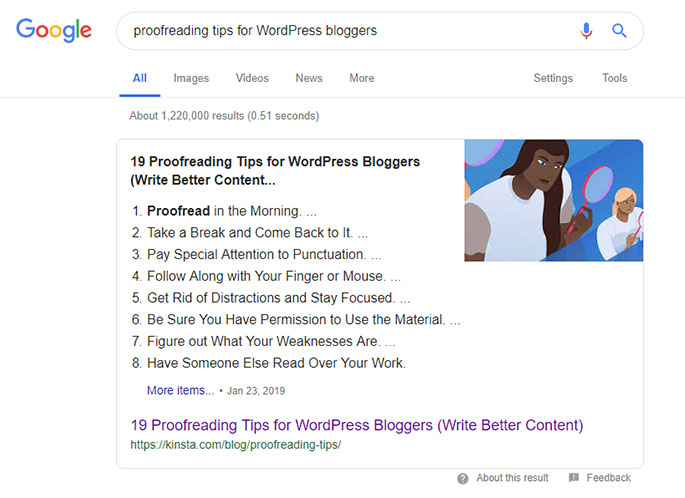
As you can see, the first post was the one from Kinsta, where I found that paragraph.
2. 4. How did a spun checker tool do?
I also tried a spun checker tool to see if it detects that content as spun, but it failed.
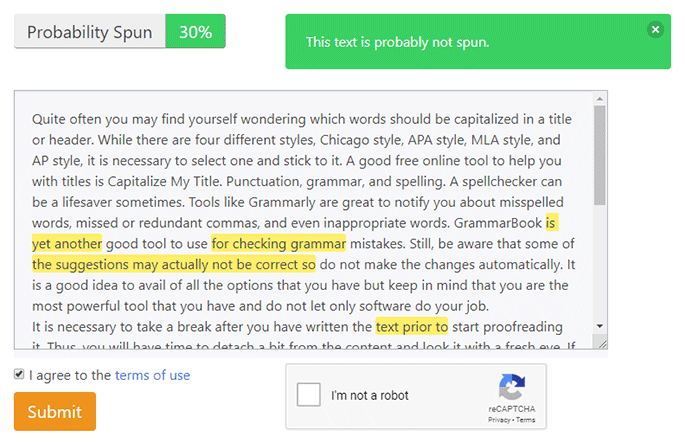
It found something, but not related to that paragraph I found.
I didn’t bother checking out what it found because I already had all the proof I needed to believe that the guest post was not original.
3. Use Google Operators
Another way to detect spun articles is to use Google operators and search for small sentences.
For example:
intitle:proofreading tips for wordpress bloggers intext:While there are four different styles, Chicago style, APA style, MLA style, and AP style.
intitle and intext are the operators.
After intitle:, add the topic you want to search for. Google will search for articles that have those words in their title.
Then, after intext:, add a small sentence. Google will search for those words in the articles’ content.
Now, in the search results, in the meta descriptions, look for similar words and sentences like the ones you added in the search operator.
Seeing too many bolded words in the same sentence is usually a red flag.
Here’s an example based on my case:
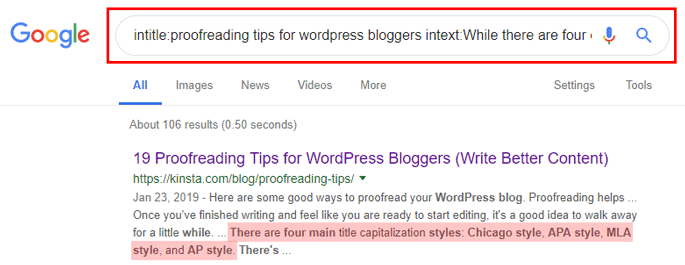
It can be hard to spot, and you also need a bit of luck to find exactly the sentences that were spun.
It’s pretty tedious, but it can work great sometimes.
You can find more Google operators here. You can use different combinations to get different results.
Conclusion
While tools can help, they are not reliable to use alone. If they don’t find anything, perform the manual checks pointed above.
I know it’s tedious work, but it will get easier once you get the hang of it.
Also, keep in mind that you won’t succeed all the time. Spun articles are pretty hard to detect, and some of them will still slip through the cracks.
I’m sure I have some spun articles myself on my blog, especially the ones from the beginning when I was just checking them for plagiarism and nothing more. 😃
That’s a Wrap
I hope this post has helped you out.
If you're interested in my web design services or free templates, want to collaborate, or just have something to say, feel free to shoot me a message.
